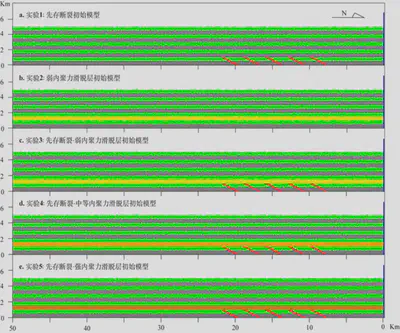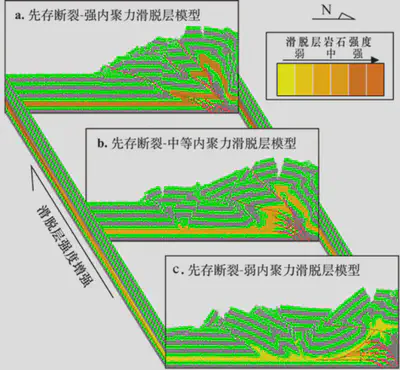Analyzing the influence of factors that control the structural deformation of fold-thrust belts in the southwestern Tianshan using discrete element simulations(Acta Geologica Sinica)
This study mainly reveals the influence of detachment layers and pre-existing faults on the deformation of thrust belts. It suggests that the development of duplex structures in the southwestern Tian Shan foreland thrust belt is primarily controlled by the Upper Cretaceous–Paleogene evaporite layers and pre-Cenozoic pre-existing faults(Xin et al.,2020)。
[Wen Xin,Hanlin Chen,Kaixuan An,Yuqing Zhang,Shufeng Yang,Xiaogang Cheng,Xiubin Lin. 2020. Analyzing the influence of factors that control the structural deformation of fold-thrust belts in the southwestern Tianshan using discrete element simulations. Acta Geologica Sinica, 94(6): 1704-1715. ](https://doi.org/10.19762/j.cnki.dizhixuebao.2020078)Title
Analyzing the influence of factors that control the structural deformation of fold-thrust belts in the southwestern Tianshan using discrete element simulations
Author
Wen Xin1,2, Hanlin Chen1,2*, Kaixuan An1,2, Yuqing Zhang1,2, Shufeng Yang1,2, Xiaogang Cheng1,2, Xiubin Lin1,2
- School of Earth Sciences,Zhejiang University, Hangzhou, 310027
- Research Center of Structures in Oil and Gas Bearing Basin,Ministry of Education, Hangzhou, 310027
Abstract
The “stacking” structure and basement involved thrust structure developed in the fold-thrust belts of the southwestern Tian Shan are obviously different from the thin skin thrust structure of the Kalpin fold-thrust belts on the eastern side. In this paper, based on structural profile interpretation, and using discrete element numerical simulation research and single factor variable control method, we have designed five sets of numerical simulation experiments to analyze the effect of controlling factors of structural evolution in the research area. We include the model of pre-existing fracture, the model of décollement and the comprehensive model of pre-existing fracture, and décollement with different cohesion. The experimental results show that the cohesion of the décollement controls the difficulty in the upward breakthrough of pre-existing faults. When the cohesion of the décollement is high, it is easy to form basement involved thrust structure along the pre-existing faults. When the cohesion of the décollement is low, the roof faults of thrust system develop in the décollement and the fault below the décollement is prevented from spreading upward. With the active pre-existing faults is easy to form thin skin imbricate structures. In the area where the low cohesion décollement is developed, the deformation front propagates faster and farther forward. The deformation primarily occurs in the upper unit and mainly contains the thrust structure and triangular belt, while the structural deformation of the lower unit is relatively weak. The “stacking” structure and basement involved thrust structure that are developed in the fold-thrust belts of the southwestern Tianshan were mainly controlled by the gypsum-salt layer of the Paleogene and the pre-existing faults of the pre-Cenozoic.

Fig.5 The initial model of the simulations

Fig.11 The numerical simulation results contrastof the different initial conditions model

Fig.12 The numerical simulation results contrastof the different cohesion decollement model
Acknowledgments
The simulation experiments in this study were conducted using the discrete element numerical simulation software VBOX, independently developed by Changsheng Li from East China University of Technology. We express our gratitude for his contribution.
Translator: Ouyang Liujuan